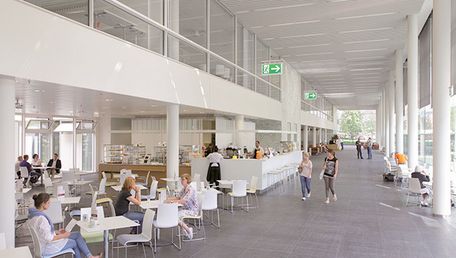Emphases
Key treatment areas
- Postradiogenic problem wounds
- Osteoradionecroses
- Therapy-refractive bone marrow inflammation
- Aseptic bone marrow necroses in children and adults
- At-risk flap pasties
- Inflammatory intestinal diseases (M. Crohn's, ulcerative colitis)
- Infected non-healing wounds (e.g. "diabetic foot")
- Compression sickness
Key research areas
- Postradiogenic breast edema
- Pain reduction in aseptic osteonecroses
- M. Crohn's disease
- Diabetes mellitus
- Glucose metabolism of tumors
- Recurrent neuroblastoma IV
HBO is the abbreviation commonly used for hyperbaric oxygenation, which involves the inhalation of pure oxygen in a pressure chamber under increased ambient pressure. Normally, the oxygen is taken in by breathing and transported into the bloodstream via the gas exchange in the alveoli.
The oxygen is bound primarily chemically to the red blood pigment, or hemoglobin, and transported into the periphery, where it is metabolized. A small amount of oxygen is already dissolved physically in the blood under normal atmospheric conditions; however, this volume is insignificant. The oxygen transporting capacity of the red blood cells is limited. In healthy individuals, arterial hemoglobin is almost completely saturated with oxygen under normal atmospheric conditions.
A significant increase in the oxygen absorption of the body cannot be achieved by means of chemical binding to the hemoglobin. During inhalation of pure oxygen under a pressure greater than one atmosphere, hemoglobin as a transport medium plays a secondary role; increased oxygen absorption can only be achieved via physical dissolution in the blood plasma.
Patient care
For the care of patients the physical and physiological mechanisms of HOB therapy are beneficial in a number of ways:
- Oxygen is supplied to human tissue chiefly by diffusion through the capillary vessels. Under hyperbaric conditions, the oxygen diffusion length can be quadrupled; i.e., oxygen reaches body cells for which the supply of oxygen is jeopardized – for example, through injury or circulatory disturbances.
- Cells responsible for the formation of new tissue in the healing of wounds require a minimum amount of oxygen to function. If this oxygen is not available, the patient may experience healing difficulty. Improved oxygen delivery during HBO therapy stimulates the production of collagen and the new formation of capillaries, activates connecting tissue cells, and promotes wound closure.
- The oxygen-dependent function of cells responsible for bone building and destroying cells is positively influenced by HBO therapy.
- The therapy acts in several ways to fight anaerobic germs that cannot survive in an oxygen rich environment. In addition, HBO treatment can improve the oxygen-dependent performance of the body’s own disease-fighting cells.
- HBO treatment results in a reactive vasoconstriction of the vessels and consecutively to a reduction in edema with additional improvement in the oxygenation of the tissue.
- In carbon monoxide poisoning, the oxygen-transporting hemoglobin is blocked by this gas. Through HBO treatment, a hemoglobin-independent oxygen supply of the tissue can be achieved through physical dissolution of the oxygen in the blood plasma. The excess supply of oxygen competes with and forces the carbon monoxide from the hemoglobin binding process, so that it is removed more quickly from the circulatory system of the body.
- In patients with decompression sickness and air embolisms, gas bubbles in the tissue or in the bloodstream are minimized and eliminated more rapidly through the overpressure and through the oxygen enrichment during HBO.
The university clinic in Duesseldorf has an ultra-modern multiple-patient pressure chamber including a mixed gas system. Over a breathing mask or in special cases a head tent, patients breathe in pure oxygen under a pressure that is greater than one atmosphere for a specified length of time. Specially trained technicians and state-of-the art control technology (such as viewing windows, video cameras, and intercom systems) contribute to optimized patient safety.
The pressure chamber is assigned to the Department of Trauma and Hand Surgery (Director: Univ.-Prof. Dr. J. Windolf) and is available across disciplines to all medical specialty areas for the treatment of hospitalized and ambulatory patients, as well as for scientific investigations.
The emphasis of treatment is on therapy of postradiogenic problematic wounds, osteoradionecroses, therapy-refractive bone marrow inflammation, aseptic necroses in children and adults, at-risk flap plasties, inflammatory intestinal diseases (M. Crohn’s disease, ulcerative colitis), infected non-healing wounds (e.g. „diabetic foot“) and decompression sickness.
Research and teaching
Researchers of HBO are involved with the treatment of postradiogenic breast edema, pain reduction in children and juveniles with serious diseases and aseptic osteonecroses, and investigation of the effects of HBO treatment on microcirculation in „diabetic foot.“
The scientists in Duesseldorf are also involved in research of the intestinal diseases M. Crohn’s, the influence of HBO treatment on the glucose metabolism of tumors, as well as the combined HBO and 131I-MIBG treatments in children with recurrent neuroblastoma IV.
In the apprenticeship program, students are offered an interdisciplinary lecture course on diverse topics of diving and overpressure medicine.




